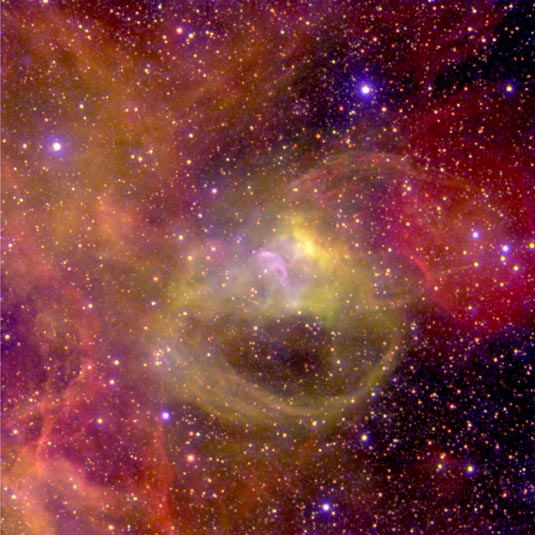
BAT99-2 in the LMC
Nebulae
RA 05h 23m 34.5s Dec -69° 45' 22?
Dorado
180,000 light years
ESO
April 9, 2003
ABOUT THIS IMAGE:
This
three-color composite image of the highly excited nebula near the Wolf-Rayet
(WR) star BAT99-2 in the Large Magellanic Cloud (LMC) was obtained in
January 2002 with the FORS1 multi-mode instrument at the 8.2-m VLT MELIPAL
telescope at the Paranal Observatory (Chile). It is based on three exposures
through narrow-band optical (interference) filters that isolate the light
from specific atoms and ions. In this rendering, the blue color represents
the light from singly ionized Helium (He II; wavelength 468.6 nm; exposure
time 60 min), green corresponds to doubly ionized oxygen ([O III]; 495.7
+ 500.7 nm; 5 min) and red to hydrogen atoms (H; H-alpha line at 656.2
nm; 5 min). Of these three ions, He II is the tracer of high excitation,
i.e. the bluest areas of the nebula are the hottest. The sky field measures
400 x 400 square arcsec; the original pixel size on the 2k x 2k CCD is
0.23 arcsec. North is up and east to the left. Before combination, the
CCD frames were flat-fielded and cleaned of cosmic-rays. Moreover, the
stars in the blue (He II) image were removed in order to provide a clearer
view of the surrounding nebular emission. The reproduced brightness is
proportional to the square-root of the actual intensity; this increases
the "dynamical range" of the image, i.e. it shows better areas
of very different brightness.
BAT99-2 is one of the hottest WR-stars known in the Large Magellanic Cloud
(LMC). Before this star reached this phase of its short life, the strong
stellar wind from its progenitor O-type star swept the interstellar medium
and created a "bubble", much like a snowplow pushes aside the snow on
a road. Part of this "bubble" can still be seen as a large half-ring to
the south of the star. When the star did become a WR, the increasingly
intense stellar wind impacted on the material previously ejected from
the star. This created a new bubble, now visible as a small arc-like structure
to the north-west of the star. We are appparently witnessing an ongoing
merger of these two bubbles. With its strong ultraviolet (UV) radiation,
BAT99-2 is strongly heating its immediate surroundings, in particular
the above mentioned arc-like feature that, due to the resulting high excitation,
is seen as a violet-pink region in the colour image. The entire field
is very complex - the presence of a supernova remnant (SNR) is revealed
by a few faint red filaments rather close to the high excitation nebula,
to the north-west of the arc-like structure.